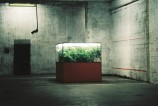DER TROST DER GUTEN FORM (Contraconstruction)
THE CONSOLATION OF CORRECT FORMS
Prototyp, Holz, Plexiglas, Metallrahmen, Pflanzen/Prototype, wood, plexiglass, metal grid, plants, 2004
de
Die Kategorie der künstlerischen Moderne par excellence ist die Form.(Peter Bürger: Das Altern der Moderne)
Die Postmoderne wäre dasjenige, das im Modernen in der Darstellung selbst auf ein Nicht-Darstellbares anspielt; das sich dem Trost der guten Form verweigert, dem Konsensus eines Geschmacks, der ermöglicht, die Sehnsucht nach dem Unmöglichen gemeinsam zu empfinden und zu teilen; das sich auf die Suche nach neuen Darstellungen begibt, jedoch nicht, um uns an deren Genuß zu verzehren, sondern um das Gefühl dafür zu schärfen, daß es ein Undarstellbares gibt.
(Jean-Francis Lyotard: Was ist postmodern?)
Das Konstruktionsprinzip des würfelförmigen Objektes beruht auf Oppostitionspaaren wie geometrisch/organisch, transparent/opak, innen/aussen, orange/grün. Angeregt durch die Lektüre von Le Corbusiers „Modulor“ habe ich mein eigenes Körpermaß als Grundlage für die Skulptur herangezogen.
Die Pflanzen im Inneren des Objektes werden dekorativ eingesetzt. Wie allgemein bekannt ist, drehen Pflanzen ihre Blätter zum Licht. So gesehen besitzt die Skulptur auch kinetische Aspekte. Zumeist werden Topfpflanzen auf Fensterbänken aufgestellt, und wenn sie lange genug dort stehen und gebührend wachsen können, bedecken sie die Glasfläche völlig mit ihren Blättern. Auf diesen Langzeiteffekt ziele ich bei dieser Skulptur ab.
Die Pflanzen stehen im Kontext des geometrischen Objektes für dessen Gegenteil, also das Nicht-gestaltete, das Chaotische und Selbstähnliche. Sie kontrastieren die rationalen, metrischen Formen und sind diesen – da sich sich in dessen Inneren befinden – doch unterworfen. Das Grün der Pflanzen steht in Widerstreit mit dem „Industrie-Orange“ der unteren Hälfte der Konstruktion.
Das System des natürlichen Wachstums wird dem System des menschlichen Rationalismus gegenüber gestellt. Es handelt sich um einen kompakten, hermetisch geschlossenen Raum. Das Innere kann eingesehen, nicht aber betreten werden. Im Inneren der Raum-im-Raum-Konstruktion befindet sich ein (fast) autonomes Biotop.
Dem Titel beigefügt ist die Bezeichnung „Kontrakonstruktion“. Dieser von Theo van Doesburg geprägte Begriff erklärt am besten das dialektische Konstruktionsprinzip des Würfels. Das orthogonale Grundgerüst aus Metall und das streng geometrische Konstruktionsprinzip würden durchaus den Dogmen der De Stijl Bewegung entsprechen, die Farbauswahl und die organischen Formen brechen das Regelwerk.
en
The perfect category of the aesthetic modern in art is form.(Peter Bürger: „The Aging of the Modern“)
The postmodern is that which, in modernism, alleges the unrepresentable within the representation … which rebels against the consolation of correct forms, against the consensus of a taste allowing people a shared feeling of nostalgia for the impossible … which seeks new ways of being represented, not for the enjoyment of it, but to make the existence of the unrepresentable more apparent.
(Jean-Francis Lyotard: „What Is Postmodern?“)
The principle of the cubic object’s construction is based on oppositional pairs such as geometric/organic, transparent/opaque, interior/exterior, orange/green. Inspired after reading Le Corbusier’s „Modulor,“ I used the dimensions of my own body as a basis for the sculpture.
The plants inside the object were employed decoratively. As is well known, plants turn their leaves toward light sources. In this respect the sculpture possesses kinetic aspects. Primarily potted plants were placed on window seats and, when left alone long enough and permitted to grow, they completely covered the glass surface with their leaves. Achieving this long-term effect was my intention with this sculpture.
In the context of the geometric object, the plants represent its opposite, i.e. the non-shaped, the chaotic and self-similarity. They represent a contrast to rational, metric forms and „as they inhabit one“ are at the same time subordinate to them. The plants‘ green color conflicts with the „industrial orange“ of the construction’s lower half.
The system of natural growth is juxtaposed with that of human rationalism. This is a compact, hermetically sealed space. The interior can be examined, but not entered. The space-within-a-space construction accommodates an (almost) autonomous biotope. Added to the title is the designation „contraconstruction.“ This term, coined by Theo van Doesburg, explains in the best possible way the dialectic principle underlying the cube’s construction. The orthogonal metallic skeleton and the rigidly geometric construction principle conform to the dogmas of the De Stijl movement, while the choice of colors and the organic forms violate its system of rules.
